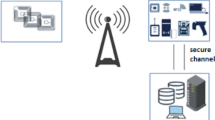Abstract
Progression of the internet technologies has led to the emergence of internet of things (IoT). One of the familiar deployment of IoT is through radio-frequency identification (RFID) technology. In recent times, RFID based systems are one of the most widely spread applications for tagging and keep tracking purposes in IoT deployment. This is due to their powerful features compared to their counterparts of similar techniques such as barcodes. In contrast, radio-frequency identification systems suffer from various attacks and security threats. The wireless channel used for communication is responsible for the majority of these vulnerabilities. In this paper, we propose a new radio-frequency identification authentication protocol based on elliptic curve cryptography (ECC) to eliminate these vulnerabilities. In addition, we use elliptic curve Diffie–Hellman (ECDH) key agreement protocol to generate a temporary shared key used to encrypt the later transmitted messages. Our protocol achieves a set of security properties likes mutual authentication, anonymity, confidentiality, forward security, location privacy, resistance of man-in-the-middle attack, resistance of replay attack and resistance of impersonation attack. We implement our proposed protocol in real RFID system using Omnikey smartcard reader (Omnikey 5421) and NXP Java smartcards (J3A040). Implementation results shows that our proposed protocol outperform in term of time complexity as compared to other similar protocols and requires less number of operations.


Similar content being viewed by others
References
Atzori Luigi, Iera Antonio, Morabito Giacomo (2010) The internet of things: a survey. Comput Netw 54(15):2787–2805
Chien Hung-Yu (2009) Development and implementation of RFID Technology, chapter the study of RFID authentication protocols and security of some popular RFID tags, page 554. i-tech, Vienna
Hof C (2006) Rfid and identity management in everyday life: striking the balance between convenience, choice and control. Report IPOL/A/STOA/2006-22, ETAG (European Technology Assessment Group), European Parliament, Strasbourg
Benssalah M, Djeddou M, Drouiche K (2012) RFID authentication protocols based on ECC encryption schemes. In: 2012 IEEE international conference on RFID-technologies and applications, RFID-TA 2012, Nice, France, November 5–7, 2012, pages 97–100
Chou J-S, Chen Y, Wu C-L, Lin C-F (2011) An efficient rfid mutual authentication scheme based on ecc. Cryptology ePrint Archive, Report 2011/418
Chou Jue-Sam (2014) An efficient mutual authentication RFID scheme based on elliptic curve cryptography. J Supercomput 70(1):75–94
Farash Mohammad Sabzinejad, Kumari Saru, Bakhtiari Majid (2016) Cryptanalysis and improvement of a robust smart card secured authentication scheme on SIP using elliptic curve cryptography. Multimed Tools Appl 75(8):4485–4504
Liao Y-P, Hsiao C-M (2012) A secure ECC-based RFID authentication scheme using hybrid protocols. In: Proceedings of the International Computer Symposium ICS 2012-Advances in Intelligent Systems and Applications, vol 2. Springer, pp 1–13
Gross H, Hlbl M, Slamanig D, Spreitzer R (2015) Privacy-aware authentication in the internet of things. Cryptology ePrint Archive, Report 2015/1110
Abdalla M, Bellare M, Rogaway P (2001) The oracle diffie-hellman assumptions and an analysis of dhies. In: Naccache D (ed) CT-RSA, volume 2020 of lecture notes in computer science. Springer, Berlin, pp 143–158
He Debiao, Zeadally Sherali (2015) An analysis of RFID authentication schemes for internet of things in healthcare environment using elliptic curve cryptography. IEEE Int Things J 2(1):72–83
Christelbach. http://www.christelbach.com/eccalculator.aspx. Accessed 10 May 2014
OMNIKEY 5421 Reader. https://www.hidglobal.com/products/readers/omnikey/5421. Accessed 15 Sept 2014
40k EEPROM J3A040 NXP JAVA based smart card. http://www.smartcardsource.com/contents/en-ca/p94_J3A040.html. Accessed 4 Apr 2013
Smart solutions for smart services : NXP. http://www.nxp.com/documents/line_card/75016728.pdf. Accessed 25 Dec 2013
Certicom Research. Standards for efficient cryptography sec 2: recommended elliptic curve domain parameters. http://www.secg.org/SEC2-Ver-1.0.pdf. Accessed 17 Mar 2014
Acknowledgments
This work was supported by the National Research Foundation of Korea(NRF) grant funded by the Korea government (MEST) (No. 2016R1A4A1011761).
Author information
Authors and Affiliations
Corresponding author
Appendix
Appendix

Rights and permissions
About this article
Cite this article
Alamr, A.A., Kausar, F., Kim, J. et al. A secure ECC-based RFID mutual authentication protocol for internet of things. J Supercomput 74, 4281–4294 (2018). https://doi.org/10.1007/s11227-016-1861-1
Published:
Issue Date:
DOI: https://doi.org/10.1007/s11227-016-1861-1




